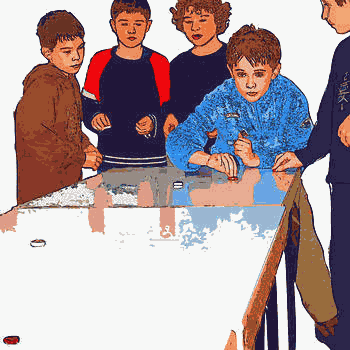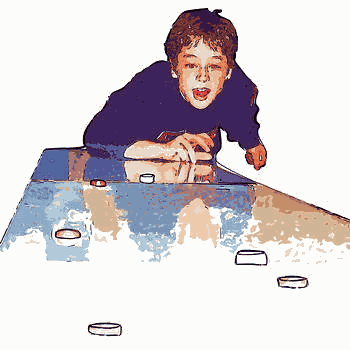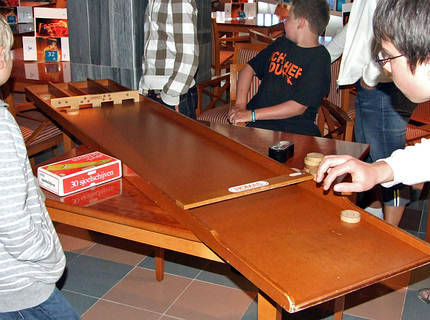source: www.youthwork-practice.com | 2000 Games, Devotions, Themes, Ideas and more for Youth Work
only for private using
Rabomberless & Shuffleboard
What do Rabomberless and Shuffleboard have in common? Both games can be played with playing pieces.
Rabomberless
Rabomberless goes without much effort. You need only one or two long tables, and some playing pieces.
The aim of this game is to push the playing pieces from one end of the table to the opposite end. The difficulty is, to develop some sensibility of pushing the playing pieces only so hard that they come as close as possible to the other table end, without dropping over the edge. Also, of course, there is always the risk that one's own well-positioned piece is pushed away by another playing piece.

©: www.youthwork-practice.com

©: www.youthwork-practice.com
In each round, the player, whose playing piece is the close to the edge, receives 3 points, the second place 2 points and the third-placed stone 1 point. The game can be played as long as 20-30 minutes. After that, you can play something else.

©: www.youthwork-practice.com
Shuffleboard
Shuffleboard is played on a board, which has some openings on the upper end. The aim is that the playing pieces are pushed through these openings. For each playing piece, which was pushed through a hole the player gets a point. If the player can get, one playing piece in each of the openings receives double points.
The pieces are larger than tokens. Each player can use 10-20 pieces. When you play Shuffleboard there are different ways to play and score. Discuss different ways and agree to them beforehand.
You can also build a Shuffleboard yourself. Just follow the instructions below. I also will give you different ways to play this game. You can use the board over and over again and even use it for a game station.
Alternatives:
What to do if you do not have a Shuffleboard or long straight tables? In this case too, I have a solution for you. You can use building blocks, wooden blocks or even stones, to build similar “goals” against a wall. Naturally, this game is played on the floor, preferably on laminated or linoleum flooring. The objective is to get the playing pieces into the little “goals” you made earlier. If you have only a carpet available; you need to use small rubber balls and roll them into the goals. Those are only a few of the creative variation you can play to promote sensitivity and fine motor skills in young people.
Another variant: Everyone knows Fuchsen/Foxing. From a 2-3 metres distance, a coin is thrown against the wall. The winner is, whose coin comes closest to the wall. All ideas put together, this can make for an enjoyable game night.
[ © www.youthwork-practice.com | 2000 Games and Ideas for Youth Work ]






